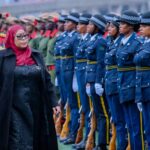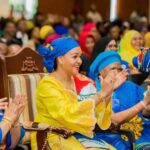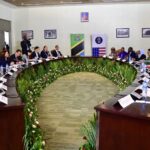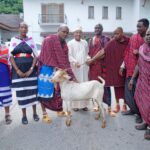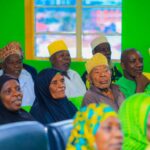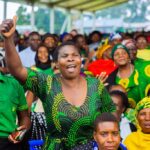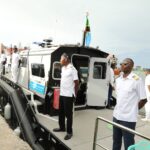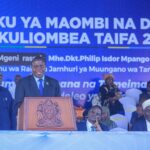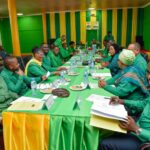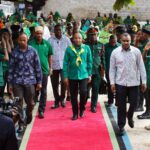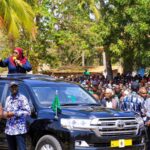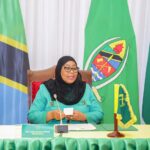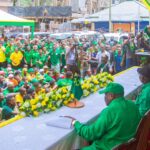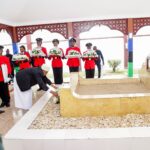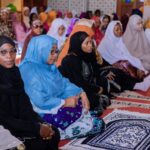The Struggle for Independence in Tanzania: A Retelling
In Tanzania, there is a prevailing perception that a select few individuals are the prominent figures in the country’s independence movement, and thus the heroes of the Tanzanian independence struggle. However, historical documentation has largely overlooked the contributions of the majority who have sacrificed for their motherland. It is our hope that the Parliament of Tanzania, upon reading this article, will pass a motion for the real history of the Tanzanian independence struggle to be rewritten.
The struggle for independence in Tanzania needs to be retold by the political actors in contemporary Tanzania. The history of Tanganyika’s struggle for independence is complex and multifaceted. While the contributions of Christians are well documented, the significant role played by Muslims and Islam remains underrepresented. This imbalance raises important questions about historical narratives and the factors that shape them.
Where Have the Heroes and Heroines Gone?
Is it that Tanzania is an ungrateful nation and therefore hates its heroes?
To understand the true political history of Tanzania, one must acknowledge the early efforts of the African Association and its leaders. The narrative that political organization began solely with Julius Nyerere in 1954 is a distortion of the facts. Recognizing the contributions of the African Association is essential to a full understanding of Tanzania’s journey to independence.
Recognizing the African Association
By presenting the historical facts clearly and accurately, we can ensure a more truthful and inclusive understanding of Tanzania’s political history.
TANU (Tanganyika African National Union) was the brainchild of Abdulwahid Sykes, not Nyerere. Its origins go back to Kleist Sykes, Abdulwahid’s father, who founded:
-
The African Association in 1929
-
Al Jamiatul Islamiyya fi Tanganyika (Muslim Association of Tanganyika) in 1933
These two associations later provided leadership to TANU in the 1950s. Unique to these two associations is the fact that the office bearers were the same for many years.
The struggle against British colonialism in Tanganyika was fought by many and from all sides. There were the well-known frontline patriots of the Tanganyika African Association (TAA) such as:
-
Abdulwahid Sykes and his young brother Ally
-
Dossa Aziz
-
John Rupia
-
Steven Mhando
-
Dr. Vedasto Kyaruzi
-
Hamza Mwapachu (1913 – 1962)
-
Idd Faiz Mafongo
-
Mshume Kiyate
-
Joseph Kasella Bantu
-
Zuberi Mtemvu in Dar es Salaam
-
Ally Migeyo
-
Saadan Abdu Kandoro
-
Paul Bomani from the Lake Region
-
Yusuf “Ngozi” Olotu from Kilimanjaro
-
Bilali Rehani Waikela
-
Germano Pacha
-
Fundi Muhindi from Tabora
-
Yusuf Chembera
-
Salum Mpunga from Lindi
-
Hamisi Heri
-
Sheikh Rashid Sembe
-
Mohamed Kajembe from Tanga
The list is long. There were also the lesser-known such as Lameck Bogohe, who is also on the list of founding members of TANU.
Women’s Groups and Societies
In this category, there were the Swahili women’s groups and societies that turned lelemama songs into songs of protest and revolution. Famous among them were:
-
Bibi Titi Mohamed (1926 – 2007)
-
Hawa Bint Maftah
-
Tatu Bint Mzee of Dar es Salaam
-
Shariffa Bint Mzee of Lindi
-
Halima Selengia of Moshi
-
Dharura Bint Abdulrahman of Tabora
-
Mwanamwema Bint Sultan of Tanga
Many others carried on their struggle against colonialism through Muslim women’s societies and “taarab” groups such as:
-
“Bomba Kusema”
-
“Egyptian”
-
“Al Watan”
-
“Saniyyat Hubb”
-
“Arab Congo”
The Role of the Muslim Clergy
The bedrock of the struggle was the Muslim clergy, the sheikhs like:
-
Sheikh Mohamed Ramia of Bagamoyo
-
Sheikh Yusuf Badi of Lindi
-
Sheikh Rashid Sembe of Tanga
And the “maalims” of the “madrasas” and the “tariqas” with the “murids” who provided membership and leadership to TANU branches all over Tanganyika. The leader of this movement was Sheikh Hassan bin Amir, the Mufti of Tanganyika and Zanzibar.
One might ask: “Where was the church, what role did the church and the Christian clergy play during the struggle?” This is the bone of contention in the history of the struggle for independence in Tanganyika.
In Tanganyika, in the absence of tribalism, the British resorted to religion to divide the people. Christians were elevated at the expense of Muslims. Christians were provided with schools to educate their children through missionary schools and government grants, while Muslims were left to fend for themselves. Muslims suffered as colonised subjects who were singled out for discrimination by being denied education, thus limiting any chance of self-advancement.
By acknowledging the contributions of all groups involved in the struggle for independence, we can foster a more comprehensive and inclusive historical narrative. This approach not only honours the diverse efforts that led to Tanzania’s independence but also provides a richer understanding of the nation’s past.
Key Points
-
Underrepresented Contributions: The significant role played by Muslims and Islam in the struggle for independence is often overlooked.
-
Historical Imbalance: The current historical narrative is skewed towards the contributions of Christians.
-
African Association: Early efforts by the African Association and its leaders are crucial to understanding Tanzania’s political history.
-
Distorted Narrative: The idea that political organization began solely with Julius Nyerere in 1954 is inaccurate.
By revisiting and retelling the history of Tanzania’s struggle for independence, we can ensure that all contributions are recognized and appreciated. This balanced approach will help create a more inclusive and accurate historical record.
Historical Context
Tanganyika, now part of present-day Tanzania alongside Zanzibar, underwent significant historical transformations under colonial rule. In the late 19th century, Imperial Germany seized this territory, incorporating it into German East Africa, which also included Rwanda and Burundi. From 1891 until the end of World War I in 1919, Germany maintained control over Tanganyika.
Following Germany’s defeat in both World War I and World War II, Tanganyika was transferred to British administration under the League of Nations Mandate System, later transitioning to the United Nations Trusteeship Council. As in other African regions, the people of Tanganyika fiercely resisted and continuously fought against the colonial overlords from the outset.
Emergence of Nationalism
In the aftermath of World War I, nascent signs of nationalism began to surface. This burgeoning national consciousness was marked by the establishment of African Associations in both Tanganyika and Zanzibar. In 1929, Tanganyika saw the formation of its African Association, initially conceived as an intellectual debating society. Over time, this organization evolved, rebranding itself in 1948 as the Tanganyika African Association (TAA).
The TAA became a crucible for nationalist sentiment, spearheading the struggle for independence following the conclusion of World War II. By 1945, the fervour for nationalism had significantly intensified, driven by the collective aspirations for self-determination and freedom from colonial domination.
The Journey Towards Sovereignty
This historical journey of Tanganyika exemplifies the resilience and determination of its people in their fight for sovereignty. The evolution from colonial subjugation to a strong nationalist movement underscores the importance of unity and intellectual engagement in overcoming imperial powers.
The Rise of Tanzanian Independence: From TAA to TANU
In 1953, under the visionary leadership of Mwalimu Julius Kambarage Nyerere, the Tanganyika African Association (TAA) was formally acknowledged as a political entity. By 1954, it had undergone a significant transformation and emerged as the Tanganyika African National Union (TANU). TANU fervently pursued the nationalist objectives of independence, and after seven years of dedicated political struggle, Tanganyika celebrated its newfound sovereignty on December 9, 1961.
A crucial milestone in this journey occurred a year prior, in 1960, when Julius Nyerere was appointed as the minister of Tanganyika, which was then under British administration. Nyerere seamlessly transitioned to the role of prime minister when Tanganyika officially attained independence in 1961. The following year, Tanganyika was declared a republic, and Julius Nyerere was elected as its first president in 1962. His presidency marked a significant shift towards socialist policies, most notably articulated through the Arusha Declaration. This declaration enshrined the principles of Ujamaa—a unique blend of African socialism and democracy—emphasizing the nationalisation of industries and the collectivisation and villagization of agriculture.
The Historical Tapestry of Zanzibar
In contrast, the history of Zanzibar is a rich tapestry woven with diverse influences. The islands were initially subjugated by Arab conquerors and later fell under European control. Consequently, the inhabitants of Zanzibar are a mosaic of mixed Arab and African heritage, predominantly adhering to Islam. Zanzibar’s experience with colonialism began centuries before Tanganyika’s struggle for independence. The islands were under the dominion of an Omani dynasty until the late eighteenth century, establishing a long-standing Arab influence.
The pivotal moment in Zanzibar’s colonial history occurred in 1891 when the British seized control and established a protectorate.
By reflecting on these histories, we gain a deeper understanding of the resilience and determination that fuelled the quest for freedom and the forging of a united identity in Tanzania.
The Roots of Unity: The Formation of Zanzibar’s Political Landscape
In the early 1930s, a constellation of football clubs emerged, laying the groundwork for what would become a significant chapter in the history of Zanzibar’s African community. By 1934, these passionate and determined individuals had established a formal organisation known as the African Association (AA). This association served as a beacon for unity and empowerment, drawing together members of the African community under a common purpose.
The Emergence of the African Association
The political climate of Zanzibar took a dramatic turn in 1955 with the formation of the Zanzibar Nationalist Party (ZNP). This development pressured the leaders of the African Association and the Shirazi Association to consolidate their efforts in response to the colonial government’s oppressive policies, which were executed in alliance with the ZNP. This strategic merger resulted in the birth of the Afro-Shirazi Party (ASP), led by the charismatic Sheikh Abeid Amani Karume.
Intense Rivalry and Factionalism
The period between 1957 and 1963 was marked by intense political rivalry and factionalism. Following the general elections, Zanzibar became a battleground for influence between the ASP, which garnered widespread support from the African majority, and the ZNP, which was backed by colonial interests. Amid this escalating tension, a new political entity emerged in 1959 – the Zanzibar and Pemba People’s Party (ZPPP). This party, led by Sheikh Muhammad Shamte, was a splinter faction that broke away from the Afro-Shirazi Party.
Struggle Against Colonial Powers
As the political landscape of Zanzibar grew increasingly volatile, the ASP and ZPPP continued their struggle against the entrenched colonial powers and the ZNP. This period of political upheaval ultimately set the stage for the transformative 1964 revolution, a seismic event that would forever alter the trajectory of Zanzibar’s history.
Zanzibar’s Political History
During a period rife with political infighting among the Afro-Shirazi Party (ASP), the Zanzibar Nationalist Party (ZNP), and the Zanzibar and Pemba People’s Party (ZPPP), the colonial government strategized for a second election.
Held on January 16, 1961, the colonial authorities declared, just a day before the election, that the victorious party would have the mandate to form its own government and preside over all ministries. The election results were intriguing: the ASP secured ten seats, while the ZNP and ZPPP garnered nine and three seats respectively.
In a surprising turn of events, the three dominant political entities concurred to put an end to their incessant bickering and animosity for the sake of unity among Zanzibaris. However, since the ASP did not achieve an outright majority, it was unable to establish a government independently. Consequently, the ZNP and ZPPP forged an alliance, creating a coalition government. Furthermore, it was decided that an interim government would be constituted, and another election would take place in June 1961 to solidify this new political landscape.
Fast forward to December 10, 1963, when the British government granted Zanzibar independence, transferring power to a party endorsed by the Sultan. This decision infuriated the African majority, who felt marginalized by the Sultan’s ascendancy.
On January 12, 1964, in a meticulously orchestrated and daringly executed revolution by the Afro-Shirazi Party members, the Sultan’s regime was overthrown. This pivotal moment led to the proclamation and establishment of the People’s Republic of Zanzibar.
This period marks a significant chapter in Zanzibar’s history, characterized by political upheaval, strategic alliances, and a decisive revolution that reshaped the island’s governance and societal structure.
In the wake of the Zanzibar Revolution that dismantled the Arab dynasty, the Republic of Tanganyika and the People’s Republic of Zanzibar forged a historic union in 1964. This agreement culminated in the creation of a new sovereign entity, the United Republic of Tanzania.
The Treaty of Union was officially signed in Zanzibar on April 22, 1964, by the first President of Tanganyika, the esteemed Mwalimu Julius Kambarage Nyerere, and the inaugural President of Zanzibar, the revered Sheikh Abeid Amani Karume. On April 26, 1964, the Articles of the Union received formal ratification from the Tanganyika Parliament and the Zanzibar Revolutionary Council. The following day, April 27, 1964, these visionary leaders exchanged the legal documents of the Union at the historic Karinjee Hall in Dar es Salaam. This momentous union was further solidified on October 28, 1964, when the Republic of Tanganyika and Zanzibar was officially renamed the United Republic of Tanzania by the United Republic (Declaration of Name) Act, No. 61 of 1964.
Consequently, Tanzania emerged as a nation with a unique two-tier system of governance. This structure comprised, firstly, the Government of the United Republic of Tanzania, which wielded sovereign authority over all Union and non-Union matters in mainland Tanzania, as delineated in the Constitution of the United Republic of Tanzania of 1977 (with subsequent amendments). Secondly, it included the Revolutionary Government of Zanzibar, which was empowered to address non-Union issues within Zanzibar. As a result, the Island Republic of Zanzibar attained a semi-autonomous status, complete with its own President and Parliament, allowing it to exercise significant self-governance.
This union represented a significant milestone in the political evolution of East Africa, heralding a new era of cooperation and unity. The creation of the United Republic of Tanzania stands as a testament to the visionary leadership and diplomatic acumen of Nyerere and Karume.
Tanzania’s Political Evolution: From Ujamaa to Multi-Party Politics
Under the visionary leadership of Julius Nyerere, Tanzania transitioned into a one-party state, laying the foundation for Ujamaa—a rural, village-based collective movement grounded in African socialism and self-reliance. Despite its noble aspirations, Ujamaa began to encounter mounting popular dissatisfaction, leading to its gradual abandonment in the 1970s and 1980s. Nyerere, who endeared himself as a pivotal figure in Tanzanian history, stepped down from the presidency in 1985 and assumed the role of an elder statesman.
Transition of Leadership
Upon Nyerere’s retirement, Ali Mwinyi, the president of Zanzibar, took the helm and initiated a series of transformative political reforms. These reforms included:
-
The introduction of multi-party politics
-
A cautious shift towards a market-oriented economy
Despite these significant changes, the Chama Cha Mapinduzi (CCM) party has maintained an unwavering grip on the political landscape, securing victories in the multiparty elections of 1995, 2000, 2005, and 2010.
Political and Economic Transformation
This era of political evolution showcases Tanzania’s dynamic journey from a socialist state to a more diversified political and economic system. It reflects the resilience and adaptability of its leadership and populace. The legacy of Nyerere’s Ujamaa and Mwinyi’s reforms continues to shape the nation’s path, offering both lessons and inspirations for future governance.
Understanding the Historical Context
By understanding the historical context and the emotional undertones of Tanzania’s political transformations, one can better appreciate the complexities and triumphs of this East African nation.
Key Points
-
Julius Nyerere’s Leadership: Transition to a one-party state and the foundation of Ujamaa.
-
Ali Mwinyi’s Reforms: Introduction of multi-party politics and market-oriented economy.
-
CCM’s Dominance: Continued political victories in multiparty elections.
-
Legacy and Lessons: The ongoing influence of Ujamaa and political reforms on Tanzania’s governance.
Evolution of Tanzania’s Political Landscape: An Analytical Overview
The Independence Constitution of 1961 laid the foundations for a parliamentary government in Tanzania, with a Prime Minister as the Head of Government and a competitive multi-party system. However, the political landscape underwent a dramatic shift with the introduction of the Republican Constitution. This new framework established a presidential system, placing an executive president at the helm as both head of state and head of government.
Key Historical Milestones
1963: Establishment of a One-Party State
A pivotal moment in Tanzania’s political history occurred on January 14, 1963, when Julius Nyerere, the nation’s visionary leader, transformed Tanganyika into a constitutional one-party state. The Tanganyika African National Union (TANU) emerged as the sole official party, rendering the formation or membership of any other political entity illegal and unconstitutional. TANU’s constitution and its ideological foundation, known as Ujamaa or African Socialism, as articulated in the Arusha Declaration, effectively became the guiding principles of the state.
1965: Interim Constitution and Unity Agreement
The Interim Constitution of 1965 further entrenched the one-party system and formally acknowledged the 1964 Unity Agreement. This agreement symbolised the unification of Tanganyika and Zanzibar, creating the United Republic of Tanzania.
1977: Permanent Constitution and Formation of CCM
The political consolidation continued with the 1977 Permanent Constitution, which recognised the merger of TANU and the Afro-Shirazi Party (ASP) to form Chama cha Mapinduzi (CCM). As the sole political entity, CCM wielded ultimate authority over all matters within the United Republic of Tanzania, maintaining its dominance until 1992.
Transition to Multi-Party System
The political winds began to shift in 1992, influenced by the recommendations of the Nyalali Commission and backed by Nyerere’s support. This period marked Tanzania’s transition to a multi-party system, which ultimately led to the first multi-party elections in 1995. Despite these democratic strides, the political arena remained largely under the control of CCM, as evidenced by their overwhelming victories in the subsequent elections of 1995, 2000, 2005, and 2010.
Current Political Landscape
While the structural shift to a multi-party system suggested a move towards greater political plurality, the reality on the ground reflects a de facto one-party dominance. The enduring influence of CCM raises questions about the true extent of democratic progression in Tanzania.
This analytical overview highlights the significant milestones in Tanzania’s political evolution, from a parliamentary government to a one-party state, and eventually to a multi-party system. Despite these changes, the dominance of CCM continues to shape the political landscape, prompting ongoing discussions about the nature of democracy in Tanzania.
The Legacy of Hamza Aziz and Dossa Aziz in Tanzania’s Independence Struggle
Hamza Aziz was a police officer in the colonial force and one of the TANU informers during the struggle for Tanganyika’s independence in the 1950s. He played a crucial role by passing on information to the TANU leadership about police plots against the party. After independence, Hamza Aziz was appointed Inspector General of Police (IGP) by Julius Nyerere.
Reflection on Dossa Aziz
Reflecting on the end of his elder brother, Dossa Aziz, who was once rich and flamboyant, Hamza Aziz came to a painful realisation. Dossa had contributed significantly to the struggle for independence, first as a party financier and then as Nyerere’s close friend, ally, and right-hand man. Despite his contributions, Hamza lamented that his brother died a poor man and did not figure anywhere in Nyerere’s life or in the history of the struggle or TANU. Dossa was one of the 17 founding members of TANU in 1954. In his sadness, Hamza uttered these words:
“Tanzania is a country without heroes. Tanzania has only one hero and that hero is Julius Kambarage Nyerere.”
The Naming Controversy
Hamza Aziz’s sadness was likely compounded by the recent decision to name a street near Mbaruku Street, where Dossa had lived during the struggle, after a controversial figure, Yusuf Makamba. Makamba, along with a Catholic priest, Camillus Luambano, was responsible for the killing of Muslims in the infamous paramilitary raid on the Mwembechai mosque in 1998.
It remains unclear what compelled the city authorities to honour Yusuf Makamba or what criteria were used to immortalise a man who, according to the majority of Muslims, had blood on his hands. This decision overshadowed the contributions of Dossa Aziz, who had played a significant role in the country’s fight for independence.
Historical Significance
Dossa’s house was one of two centres where young nationalists met to organise and strategize against the British. The other was Abdulwahid Sykes’ house on Aggrey Street. These two houses should have been preserved and made national monuments for posterity, recognizing their importance in Tanzania’s history.
Little did Hamza Aziz know at the time that the legacy of his brother and their contributions to the independence struggle would continue to be a topic of reflection and debate in Tanzania’s historical narrative.
Zanzibar’s Political History
Zanzibar’s political history is a tapestry of intricate events, profound issues, and compelling theories. Among the most resonant narratives embraced by Zanzibar’s revolutionaries is the contested legacy of Arab slavery, which they identify as the catalyst for the Zanzibar Revolution of January 1964. This official historiography, embedded in the school curriculum for over fifty years, worships its own pantheon of ‘official heroes’.
Key Players in the Revolution
Foremost among these heroes are:
-
Afro Shirazi Party (ASP) led by Abeid Amani Karume
-
Umma Party led by Mohamed Abdulrahman Babu
-
A dedicated faction of ‘comrades’ who claim to have meticulously orchestrated and executed the overthrow of the Arab oligarchy.
However, this narrative offers little recognition of the foundational role played by the Zanzibar Nationalist Party (ZNP), more commonly known as Hizbu, in establishing the foundations of party politics and democracy on the islands.
Equally overlooked is the crucial involvement of the Makonde tribesmen, a formidable force recruited from the sisal estates of Sakura and Kipumbwi in Tanga, Tanganyika. Smuggled into Zanzibar with clandestine precision and armed only with machetes, these mercenaries were recruited to support the ASP’s efforts.
The Night of Revolution
On that fateful night of revolution and the following day, the Makonde fighters unleashed a wave of violence, ruthlessly targeting the so-called Arabs whom they believed had subjected Africans to centuries of brutal enslavement. This grim episode is a crucial but often under-reported chapter in the wider saga of Zanzibar’s tumultuous political evolution.
Absence of Recognition
In the annals of the Zanzibar revolution, there is a conspicuous absence of any mention of an army of mercenaries or the individuals who orchestrated, financed, and executed the so-called invasion of Zanzibar from Tanganyika, as described by Ali Muhisin and Sultan Jamshid. Half a century after the upheaval, members of the Afro-Shirazi Party (ASP) steadfastly deny any involvement of these mercenaries.
This structured overview of Zanzibar’s political history highlights the complexities and often overlooked narratives that have shaped the islands’ past.
The Untold Stories of the Zanzibar Revolution
The names of Julius Nyerere, Kassim Hanga, and Oscar Kambona, who were at the centre of the conspiracy, do not appear anywhere in the history of the revolution. Nor do the names of Victor Mkello and Mohamed Omari Mkwawa, the two who, with the connivance of the Tanganyika state machinery, recruited the Makondes from the sisal estates in Sakura to vote for the ASP in the 1963 Zanzibar elections and to overthrow the government in 1964. But these Makondes remain faceless and nameless today, after years of denial and repression of their role in the revolution.
The Missing Okello Tapes
Where are the Okello tapes? Are they not part of the history of Zanzibar? Should they not be played and listened to by the people during the anniversary of the revolution? Or are the tapes and Okello’s role in the revolution an embarrassment today? Can a nation deny its own existence and therefore its own history?
Overlooked Figures in the Revolution
The names of Jumanne Abdallah and Ali Mwinyi Tambwe, the two top government leaders in the Tanga region who were involved in laying the groundwork for the invasion from Kipumbwi, are nowhere to be found in the saga. Throughout his life, Ali Mwinyi Tambwe refused to talk about his role in the Zanzibar revolution.
The Absence of Algerians and Israelis
But the jewel in the crown is the absence of Algerians and Israelis in the story of the Zanzibar Revolution, just as much has been written about the role of the United States government and Britain. Ben Bella, the President of Algeria, provided arms that were received in Dar es Salaam, and Israelis are believed to have played a subtle role through Moshe Finsilber, although it is not clear what Moshe actually did. More research is needed to uncover Moshe Finsilber’s true role in the Zanzibar revolution.
Missing Political Actors
No wonder that many political actors are missing from the dramatis personae of the Zanzibar Revolution play. The history of atrocities committed by the Zanzibar Revolutionary Council and the ‘Committee of Fourteen’ led by the notorious Seif Bakari and his followers is another area that remains to be explored.
This article aims to shed light on the overlooked and suppressed aspects of the Zanzibar Revolution. The contributions and roles of various individuals and groups have been obscured, and it is crucial to acknowledge their impact to fully understand this historical event.
Uncovering the Dark Days in Zanzibar (1964-1972)
Despite this, there have been attempts by individuals to uncover what happened during the dark days in Zanzibar, particularly from 1964 to 1972. Among those who tried to uncover the truth, Ali Nabwa’s name stands out as a lone voice.
Key Figures
Ali Nabwa
Ali Nabwa is notable for his efforts to reveal the truth about the events in Zanzibar during this period. His work, particularly his ‘Prison Letters’, has been a significant source of information.
Jim Bailey
Jim Bailey, the owner of the Drum magazine, was the first person to come across Ali Nabwa’s ‘Prison Letters’. These letters were first seen by this writer in 1994 and were described years later in an obituary following Ali Nabwa’s death in 2007.
Encountering Nabwa’s Pen: A Journey Through Prison Letters
It was through this manuscript that I first came face to face with Nabwa’s pen, through his prison letters. The letters introduced me to Nabwa’s mind in a way that I cannot find words to describe. In those letters, Nabwa’s pen did not write; it cried and whipped. The words from Nabwa’s pen took me to another world, a world I had never imagined existed.
The First Letter: 1973, Central Police Station, Dar es Salaam
The first letter, written in 1973 from the Central Police Station in Dar es Salaam, shocked me. In it, Nabwa described police intimidation and torture in the style of the Ton Ton Macouts of Papa Doc’s Haiti. In Nabwa’s sense of humour, he says in the letter that it would take a Dickens to describe the squalor of the cell he was in.
Letters from Ukonga Prison
The letters that followed were all from the Condemned Section of Ukonga Prison. In his analysis of the personalities people were led to believe were symbols of justice and principle, Nabwa’s pen stripped away the charade and camouflage to reveal their true colours and identities.
A Potpourri of Revelations
Nabwa’s letters were a potpourri of:
-
Short biographies
-
Dossiers
-
Profiles
-
Hit lists of ‘enemies’ and their method of execution
In the prison letters, Nabwa’s pen exposed the atrocities that took place in Zanzibar after the revolution and analysed the arrogance, mediocrity, and sheer short-sightedness of the leadership.
Reflections
Looking back, I am glad that I was one of those privileged to read Nabwa’s revelations of injustice in Zanzibar before he became a celebrity of sorts and his insightful articles a major topic of discussion in the corridors of power.
The Unveiling of Atrocities in Zanzibar
The atrocities that no one had the courage to talk about publicly for almost forty years were laid bare for all to read through Dira, the newspaper Nabwa founded in 2004. Dira was the first free newspaper in Zanzibar since the revolution. The waves of Nabwa’s pen were electrifying. Dira became a paper eagerly awaited each week by the public, including Zanzibar’s leadership. Its circulation increased with each passing week.
The Impact of Dira
Nabwa’s pen lifted the lid in broad daylight. The stories of betrayal, rape, murder, homosexuality, and forced marriages by members of the Revolutionary Council and their cronies in Zanzibar were there, with names, places, and accomplices, for all to read and judge. Those who had demonized the Sultan had no tongue to defend their own ‘upright’ record. The young generation began to ask questions, and in the answers, they saw the rulers and the revolution in a completely different light.
A Clean Exit for the Sultan
On the contrary, the Sultan left Zanzibar with his hands clean of blood. The same cannot be said of the government that came to power after the revolution. Adam Shafi, himself a victim of these atrocities, has vividly described the period in his novel Haini, which is thinly and unconvincingly disguised as fiction.
By presenting these stories, Dira played a crucial role in reshaping the public’s understanding of their history and leadership. The revelations not only sparked conversations but also encouraged a critical examination of the past, leading to a more informed and questioning society.
Key Points
-
Dira Newspaper: Founded by Nabwa in 2004, the first free newspaper in Zanzibar since the revolution.
-
Revelations: Exposed stories of betrayal, rape, murder, homosexuality, and forced marriages by the Revolutionary Council.
-
Public Reaction: Increased circulation and public anticipation each week.
-
Historical Reassessment: Led to a new perspective on the rulers and the revolution.
-
Adam Shafi’s Novel: Haini describes the atrocities, albeit thinly disguised as fiction.
This article highlights the importance of free press in uncovering hidden truths and fostering a more transparent and accountable society.
The Untold Political History of Tanganyika and Zanzibar
The political history of Tanganyika and Zanzibar has remained largely undocumented, apart from the efforts of the author of this article to present a contrary view to the official history. The official version has conveniently omitted the crucial role of many patriots. The corrective version has sought to bring these forgotten patriots back into the story, including the unpalatable realities and hard facts.
Forgotten Heroes of East Africa
Yash Tandon has lamented the neglect of the patriots who fought for the independence of their countries. Tandon described the forgotten heroes like Abdulwahid Sykes and other patriots such as:
-
Chege Kibachia
-
Makhan Singh
-
Fred Kubai
-
James Kivu
-
I.K. Musazi
-
Erika Fiah
-
Gama Pinto
These individuals were described as “veteran leaders of the struggle of the peoples of East Africa… whom our recent historians have forgotten.”
The Impact of “The Life and Times of Abdulwahid Sykes”
In Tanzania, the book The Life and Times of Abdulwahid Sykes (1924 – 1968): The Untold Story of the Muslim Struggle against British Colonialism has completely changed the history of Tanganyika’s struggle for independence. It has brought to the fore patriots who were involved in the struggle many years before Nyerere.
Key Revelations
The most shocking revelation in the book was the fact that TANU (Tanganyika African National Union) was the brainchild of Abdulwahid Sykes, not Nyerere. Its origins go back to Kleist Sykes, Abdulwahid’s father, who founded:
-
The African Association in 1929
-
Al Jamiatul Islamiyya fi Tanganyika (Muslim Association of Tanganyika) in 1933
These two associations later provided leadership to TANU in the 1950s. Unique to these two associations is the fact that the office bearers were the same for many years.
The Forgotten Patriots of East African Independence
By deliberately burying those who fought for independence, part of the history of these countries has been lost. Students of political history in East African countries are in the dark about important events that took place and were carried out by the forgotten patriots.
Key Historical Events
For example, few are aware that in 1950:
-
The Kenya African Union (KAU) and the Tanganyika African Association (TAA), through their leaders Kenyatta and Abdulwahid, attempted to link the Kenyan struggle during the Mau Mau with that in Tanganyika.
-
A secret meeting between the two was held in Nairobi.
The Meru Land Case
During the Meru Land Case in 1950, Tanganyika asked Kenya for help in confronting the settler community in Meru. There were also Kenyans on the TAA executive committee, prominent among them were:
-
Dome Okochi Budohi
-
Patrick Aoko
-
C Ongalo
These three Kenyans in the TAA executive committee served alongside Abdulwahid Sykes and Nyerere and were among the early members of the African National Union (TANU) when the party was formed in 1954.
A Testament to a Rich History
The information below is a testament to a rich history that has remained unknown for many years:
A Secret Meeting in Nairobi
Abdulwahid and his friend Ahmed Rashad Ali went to a house in the suburbs, which was in the dark and surrounded by Mau Mau guards. He was expected. Kenyatta was informed and came out of the house to meet him. This meeting took place under cover of darkness, probably in Eastleigh in the suburbs of Nairobi, where most of the Mau Mau meetings took place in the 1950s before the emergency.
Ahmed Rashad Ali remembers hearing Kenyatta call Abdulwahid by name. Kenyatta had known Ally Sykes in Nairobi in 1946, and it is likely that Abdulwahid’s work was facilitated by this acquaintance. Ahmed Rashad Ali met Kenyatta and they shook hands. After the introductions, Kenyatta, Abdulwahid, Fred Kubai, Bildad Kaggia, and Kungu Karumba went into another room where the meeting took place. Ahmed Rashad remained outside with a guard.
Historical Events and Figures in East African Independence Movements
Proposed Meeting in Arusha
Another meeting was proposed by Kenyatta to be held in Arusha, where the Tanganyika African Association (TAA) was to be presented by:
-
Abdulwahid Sykes
-
Steven Mhando
-
Dossa Aziz
However, this meeting never took place as Operation Anvil was launched soon after.
Operation Anvil and Its Impact
In 1955, Dome Budohi and Patrick Aoko, along with other Kenyans, were rounded up in Dar es Salaam as a result of Operation Anvil, which was launched in Kenya in 1954. Budohi and Aoko, active members of the Tanganyika African National Union (TANU), were detained at the Central Police Station in Dar es Salaam and kept in chains.
Key Facts about Dome Budohi
-
First Kenyan to join TANU
-
Proud holder of TANU card number 6
Budohi and Aoko were interrogated for six months before being sent to a camp in Handeni for transport to detention camps in Kenya. Budohi was eventually detained on Lamu Island. The Kenyan nationalists were transported in chained cattle carts through Korogwe and Taveta on their way back to Kenya. Ally Sykes, one of the 17 founders of TANU, who had been transferred to Korogwe as punishment, went to the station to see them off.
Rashid Mfaume Kawawa’s Role
Among the staff working at the Handeni camp was Rashid Mfaume Kawawa, who would later become Vice-President of Tanganyika. Interestingly, Kawawa’s biography does not mention his time at the Handeni camp or his interactions with these Kenyan patriots.
Missing Historical Accounts
-
Kawawa’s Biography: No mention of his time at Handeni camp or the Kenyan patriots.
-
Nyerere’s Statements: No reference to these Kenyan nationalists.
Cultural Contributions
Both Budohi and Kawawa were notable entertainers of their time in 1950s Dar es Salaam:
-
Dome Budohi: Talented musician who played with the Sykes brothers in the Skylarks Band.
-
Rashid Mfaume Kawawa: Actor.
The Unspoken History of Kawawa and Budohi
Budohi and Kawawa were more than just acquaintances; they shared a significant history. They had acted together in a film called Wageni Wema, produced by the Department of Community Development. Additionally, both were aspiring young politicians, which likely created many fond memories for Kawawa.
Missing References in Kawawa’s Book
It is peculiar that Kawawa’s book makes no reference to his personal papers. These documents are crucial not only to Kawawa’s life story but also to the history of Tanganyika. Furthermore, the book omits mention of his contemporaries and fellow trade unionists in the Tanganyika African Government Servants Association (TAGSA), such as:
-
Ally Sykes
-
Dr. Wilbard Mwanjisi
-
Thomas Marealle
-
Others
Speculations on the Omissions
The reasons for these omissions can only be speculated. It is now known beyond a shadow of a doubt that such information was suppressed. The suppression was likely because it was not in the interest of those in power to acknowledge that efforts to liberate the country existed before their time.
The Struggle Against British Colonialism in Tanganyika
The struggle against British colonialism in Tanganyika was fought by many and from all sides. There were the well-known frontline patriots of the Tanganyika African Association (TAA) such as:
-
Abdulwahid Sykes and his young brother Ally
-
Dossa Aziz
-
John Rupia
-
Steven Mhando
-
Dr. Vedasto Kyaruzi
-
Hamza Mwapachu (1913 – 1962)
-
Idd Faiz Mafongo
-
Mshume Kiyate
-
Joseph Kasella Bantu
-
Zuberi Mtemvu in Dar es Salaam
-
Ally Migeyo
-
Saadan Abdu Kandoro
-
Paul Bomani from the Lake Region
-
Yusuf “Ngozi” Olotu from Kilimanjaro
-
Bilali Rehani Waikela
-
Germano Pacha
-
Fundi Muhindi from Tabora
-
Yusuf Chembera
-
Salum Mpunga from Lindi
-
Hamisi Heri
-
Sheikh Rashid Sembe
-
Mohamed Kajembe from Tanga
The list is long. There were also the lesser-known such as Lameck Bogohe, who is also on the list of founding members of TANU.
Women’s Groups and Societies
In this category, there were the Swahili women’s groups and societies that turned lelemama songs into songs of protest and revolution. Famous among them were:
-
Bibi Titi Mohamed (1926 – 2007)
-
Hawa Bint Maftah
-
Tatu Bint Mzee of Dar es Salaam
-
Shariffa Bint Mzee of Lindi
-
Halima Selengia of Moshi
-
Dharura Bint Abdulrahman of Tabora
-
Mwanamwema Bint Sultan of Tanga
Many others carried on their struggle against colonialism through Muslim women’s societies and “taarab” groups such as:
-
“Bomba Kusema”
-
“Egyptian”
-
“Al Watan”
-
“Saniyyat Hubb”
-
“Arab Congo”
The Role of the Muslim Clergy
The bedrock of the struggle was the Muslim clergy, the sheikhs like:
-
Sheikh Mohamed Ramia of Bagamoyo
-
Sheikh Yusuf Badi of Lindi
-
Sheikh Rashid Sembe of Tanga
And the “maalims” of the “madrasas” and the “tariqas” with the “murids” who provided membership and leadership to TANU branches all over Tanganyika. The leader of this movement was Sheikh Hassan bin Amir, the Mufti of Tanganyika and Zanzibar.
All these patriots mentioned above were heroes in their own way. Sadly, they are all missing from Tanganyika’s political history.
The Role of Religion in Tanganyika’s Independence Struggle
One might ask: “Where was the church, what role did the church and the Christian clergy play during the struggle?” This is the bone of contention in the history of the struggle for independence in Tanganyika.
The Overlooked Role of Muslims
The official version has conveniently omitted the crucial role of Muslims and Islam as an ideology of colonial resistance to foreign rule in Tanganyika. In Tanzania, it is taboo to associate the struggle for independence with Islam and Muslims.
Questions on the Church’s Role
-
Is it because the church never played a significant role in the struggle for independence in Tanganyika?
-
It is also a fact that Christians took leading positions in the independence government and still monopolize these positions because of their superior education.
-
Could this be the reason why the Muslim contribution to the independence struggle has been downplayed over the years?
Nyerere’s Reluctance to Document the Struggle
It is said that those close to Nyerere urged him to write about the independence struggle, but he always refused. Oxford University Press, which published many of his books, even sent an emissary to him to discuss the subject, but he refused.
Possible Reasons for Refusal
-
Could fear of Muslims have been the reason for his refusal?
The narrative of Tanganyika’s independence struggle is complex and multifaceted. While the contributions of Christians are well-documented, the significant role played by Muslims and Islam remains underrepresented. This imbalance raises important questions about historical narratives and the factors that influence them.
The Role of Heroes in African Independence Movements
Leaders in Africa seem to fear heroes other than themselves. If Bildad Kaggia had not written his autobiography, Roots of Freedom, the history of the Mau Mau in Kenya as a peasant movement against British colonialism would have many gaps. Without this and many other works by other patriots, it would not have been possible to associate the Kenyan struggle with the names of patriots such as Jaramogi Oginga Odinga, Pio Gama Pinto, Makhan Singh, and Dedan Kimathi.
The Kikuyu and the Mau Mau in Kenya
Just as it is difficult to separate the Kikuyu and the Mau Mau from the struggle in Kenya, so it is impossible to separate the role of the Muslims in spearheading the struggle against the British and in founding TANU, the party of independence. The Kikuyu bore the brunt of colonialism more than any other ethnic group in Kenya, just as Muslims suffered more than any other group in colonial Tanganyika.
British Tactics of ‘Divide and Rule’
In Kenya, the British’s tactic of ‘divide and rule’ focused on ethnic division. The British appropriated land from the Kikuyu, turning the Kikuyu into squatters on their own land. As a result of this land-grabbing policy by the British settler community, the Kikuyu rose up and engaged the British through the Mau Mau.
The Role of Muslims in Tanganyika
In Tanganyika, in the absence of tribalism, the British resorted to religion to divide the people. Christians were elevated at the expense of Muslims. Christians were provided with schools to educate their children through missionary schools and government grants, while Muslims were left to fend for themselves. Muslims suffered as colonised subjects who were singled out for discrimination by being denied education, thus limiting any chance of self-advancement.
The Struggle for Survival
The survival of Muslims as a people and Islam as a religion therefore lay in the total overthrow of the colonial state.
By understanding the distinct yet interconnected struggles of the Kikuyu in Kenya and the Muslims in Tanganyika, we gain a deeper appreciation for the complex dynamics of colonial resistance in Africa. The contributions of heroes like Bildad Kaggia and others are crucial in preserving the rich history of these movements.
Key Figures in the Kenyan Struggle:
-
Bildad Kaggia: Author of Roots of Freedom
-
Jaramogi Oginga Odinga
-
Pio Gama Pinto
-
Makhan Singh
-
Dedan Kimathi
Key Points:
-
The British used ethnic and religious divisions to maintain control.
-
The Kikuyu and Muslims were particularly targeted and suffered under colonial rule.
-
The fight for independence was marked by significant contributions from various patriots.
By documenting and remembering these struggles and the heroes involved, we ensure that the history of African independence movements remains complete and honoured.
The Impact of Colonial Factionalism on Emerging African Nations
A nation formed from a historical background of factionalism, such as in Tanganyika and Kenya, where these divisions were created by the colonising power for the sole purpose of creating divisions among the people, will undoubtedly face problems as it emerges as an independent African nation.
Challenges During the Struggle for Independence
-
Lukewarm Support: During the struggle for independence, certain factions within the body politic may offer only lukewarm support.
-
Fence-Sitting Factions: Some factions may prefer to sit on the fence as a reliable mechanism to protect their privileges under the colonial framework. These factions feel that colonialism is beneficial to them because of the privileges granted by the colonial government.
Post-Colonial Environment
In a post-colonial environment, all factions, including those that were previously on the fence, will want to share power regardless of their position during the struggle for independence. These factions will no longer be satisfied with crumbs; they will demand a significant share of the capacity building and state building efforts.
Direction of the Country
The direction of the country and the interpretation of the people’s history will depend on who takes the reins of power. If the comprador class takes power after independence, the country may find itself in a situation similar to many African countries today.
Potential Issues with the Comprador Class in Power
-
Finding Enemies: The tendency has been for this class in power to try to find enemies among those who fought for freedom in order to justify and maintain their position in society.
-
Rewriting History: The heroes who fought for independence can be turned into enemies of the state with the stroke of a pen.
The historical background of factionalism created by colonial powers poses significant challenges for emerging African nations. The struggle for independence and the post-colonial environment are fraught with complexities, particularly regarding power-sharing and the interpretation of history. The direction of the country will largely depend on who assumes power and how they choose to navigate these inherited divisions.
The Political History of Tanzania
The political history of Tanzania is a victim of the official history and the witch-hunt that followed immediately after independence. Official histories, which are the norm in many authoritarian regimes, pick and choose what they deem appropriate to include in a nation’s history. The ‘truth’ according to official histories is usually at odds with the facts.
For many years, people were led to believe that the need for the people of Tanganyika to have a political party to fight for independence began with Julius Nyerere in 1954. This is a fallacy. The urge for the people of Tanganyika to organise began in 1929 with the formation of the African Association (AA) in Dar es Salaam.
The trend in Tanzania has been to downplay the quarter-century history of the African Association and its leadership. The achievements of the African Association remained undocumented and very little was known about its leadership.
Key Points
-
Official Histories: Often manipulated by authoritarian regimes to present a selective version of events.
-
Misconception: The belief that the political movement in Tanganyika started with Julius Nyerere in 1954.
-
Historical Truth: The political organization began in 1929 with the African Association in Dar es Salaam.
-
Neglect of AA: The significant contributions and leadership of the African Association have been largely ignored and undocumented.
The Sykes Family and the Formation of TANU
In 1986, after almost 25 years of silence, Ally Sykes, one of the founding members of TANU in 1954, gave an interview to British journalist Paula Park. Sykes was notable for holding TANU card No. 2 and for issuing card No. 1 to Julius Nyerere, bearing his signature.
Paula Park’s Article
Paula Park wrote a full-page article on the Sykes family’s contribution to the political development of Tanganyika, culminating in the formation of TANU in 1954. Shortly after the article’s publication, Park was visited by immigration officials and quietly asked to leave the country.
Recognition of Forgotten TANU Pioneers
In 1988, an article was published in African Events that gave prominence to Abdulwahid Sykes and other forgotten TANU pioneers. This article contradicted the official story and was met with threats, hostility, and sometimes outright contempt.
Official Response
The author of the African Events article received a stinging rebuke from party historian Dr. Mayanja Kiwanuka. Dr. Kiwanuka was a leading member of the panel that wrote Historia ya Chama Cha TANU 1954-1977, the official history of TANU. This particular edition of the history was quietly withdrawn from circulation because the article contradicted the official TANU history.
Formation of a Multiracial Political Party in 1951
In 1951, several notable figures were approached to support the formation of a multiracial political party. These figures included:
-
Abdulwahid and Ally Sykes
-
Mwapachu Dr. Joseph Mutahangarwa
-
Chief Abdieli Shangali of Machame
-
Paramount Chief Thomas Marealle of Marangu
-
Chief Adam Sapi Mkwawa
-
Chief Harun Msabila Lugusha
-
Dr. Mwanjisi
-
Abdulkarim Karimjee
-
Dr. Vedas Kyaruzi
-
Juma Mwindadi
-
H. K. Viran
-
Stephen Mhando
-
Dossa Aziz
These individuals were asked by Ivor Bayldon, Brig. Scupham, and V.M. Nazerali to support this new political initiative. Notably absent from this list is the name of Julius Nyerere.
Legislative Council Members
Bayldon, Scupham, and Nazerali were members of the Legislative Council. Among the African members of the Legislative Council who were enthusiastic about this new development of interracial alliance in politics were:
-
Chief Kidaha Makwaia
-
Yustino Mponda of Newala
However, Abdulwahid and the TAA inner circle refused to support the idea because, in their minds, TANU already existed.
Abdulwahid Sykes’ Efforts
Abdulwahid Sykes had tried in vain for many years to persuade the powerful Chief David Kidaha Makwaia of Shinyanga to join the TAA, be elected president, and then form TANU. Chief Kidaha had made his mark in colonial Tanganyika politics in the Legislative Council. It was clear to many that Chief Kidaha would lead the country as its first Prime Minister in free Tanganyika.
Chief Kidaha’s Stance
Unfortunately for Chief Kidaha, while he seemed ready to lead the Africans of Tanganyika, he felt that leadership should come to him through a political process initiated by the British and not through the political movement of the TAA led by ‘agitators’ such as:
-
Abdulwahid Sykes
-
Hamza Mwapachu
-
Sheikh Hassan bin Amir
These individuals were members of the TAA Political Subcommittee. Chief Kidaha politely declined Abdulwahid’s offer.
Julius Nyerere’s Acceptance
When Abdulwahid made the offer to Julius Nyerere in 1953, Nyerere accepted. He was elected TAA President in June 1953, and soon after, TANU was formed in July 1954.
Recognition of Contribution
Despite their significant contributions, Abdulwahid and Ally Sykes, including their father Kleist Sykes and other patriots, are not mentioned in the history of TANU.
The Origins and Contributions of TANU: A Focus on the Sykes Family and Chief Kidaha
It is impossible for any researcher to trace the origins of TANU outside the Sykes family circle. When Abdulwahid Sykes died in 1968, Brendon Grimshaw, then editor of the Tanganyika Standard, wrote an obituary in which he paid glowing tribute to the Sykes family for their contribution to Tanganyika’s political development. He stated without mincing words or fear that “much of the desire among Africans for a strong political party in Tanzania came from the impetus of the Sykes family.”
The Marginalization of Key Figures
Any attempt to rewrite the history of TANU by focusing solely on Nyerere and marginalizing other patriots is bound to face many obstacles. Chief Kidaha and Abdulwahid Sykes are barely mentioned in the history of TANU. Was Nyerere aware of what had happened between Abdulwahid Sykes and Chief Kidaha before he came on the scene?
The Fate of Chief Kidaha
As fate would have it, Nyerere abolished chiefdoms soon after independence. Soon after, Chief Kidaha was arrested and banished to Tunduru, a remote area in southern Tanganyika. Did Chief Kidaha have time to reflect on his misjudged decision to shun TAA and Abdulwahid’s offer? When he was released from prison, Chief Kidaha emigrated to Kenya.
The Untold Story of Chief Kidaha
Chief Kidaha’s story and his contribution to Tanganyika’s political development while serving as a member of the Legislative Council in the 1950s is not known to many students of Tanganyika’s history. It is a pity that Chief Kidaha never spoke publicly about his political life and why he fell out with Nyerere. Chief Kidaha’s obituary said of his place in African politics in the 1950s:
“Aware of the white man’s ambitions for him, the shrewd chief avoided contact with the ‘Young Turks’ in the nationalist movements that were emerging at the time.”
The contributions of the Sykes family and Chief Kidaha to Tanganyika’s political development are significant yet often overlooked. Understanding their roles provides a more comprehensive view of the history of TANU and the political landscape of Tanganyika.
Understanding Chief Kidaha’s Position in the Decolonization of Tanganyika
It is now easy to understand Chief Kidaha’s position at the time with the publication of new information on the decolonisation of Tanganyika. There is now new information that from 1950 the Special Branch embarked on a systematic campaign of surveillance of the TAA leadership. The names of Abdulwahid Sykes (whom the reports contemptuously referred to as a Zulu), Steven Mhando, Hamza Mwapachu (whom the government labelled ‘communists’), and Mashado Plantan, editor of Zuhra, were high on the Special Branch list.
Chief Kidaha could not have been unaware of this, given his proximity to Governor Edward Twining and the colonial government. Historians in Tanzania have ignored Chief Kidaha Makwaia just as they have ignored Abdulwahid Sykes. This is why the genesis of the mass mobilization and the formation of TANU have skipped the two of them, including others who were in the TAA Political Subcommittee. The focus has always been on Nyerere and Nyerere alone, forgetting the fact that Nyerere came into the limelight in 1953 when he defeated incumbent Abdulwahid Sykes for the presidency of the TAA.
And again, it is strange that when it is necessary to mention that Nyerere took over the leadership of the TAA in 1953, the names of the TAA leaders are usually not mentioned.
Key Points
-
Special Branch Surveillance: From 1950, the Special Branch conducted a systematic campaign of surveillance on TAA leadership.
-
Chief Kidaha’s Awareness: Given his close relationship with Governor Edward Twining and the colonial government, Chief Kidaha was likely aware of the surveillance.
-
Historical Oversight: Historians have largely ignored Chief Kidaha Makwaia and Abdulwahid Sykes.
-
Omission of TAA Leaders: When discussing Nyerere’s takeover of the TAA leadership in 1953, the names of other TAA leaders are often omitted.
The new information on the decolonization of Tanganyika sheds light on the overlooked contributions and positions of key figures like Chief Kidaha and Abdulwahid Sykes. It is crucial to acknowledge these individuals to provide a more comprehensive understanding of the historical narrative surrounding the formation of TANU and the broader decolonization efforts.
The Propagandists, the Singers, and the Songs of Freedom
Introduction to Radio Broadcasting in Tanganyika
Radio broadcasting was introduced in Tanganyika in 1952. The colonial government set up a radio station called Sauti ya Dar es Salaam, which later became known as the Tanganyika Broadcasting Corporation (TBC). The radio was mainly used by the colonial government for its own purposes of disseminating information relevant to its own administrative policies and propaganda.
Entertainment and Music
In between these tasks, the government played music for the entertainment of Africans and its colonial staff. This change brought a variety of music and artists from outside Tanganyika into the country. The record company His Masters Voice (HMV), which had a red label for music from Europe, introduced the blue label, which was reserved for recording ‘indigenous’ music. This encouraged local artists to compose and record their music, which found its way onto the local airwaves.
Evolution of African Music
Over time, African music gradually changed its tempo from love songs to songs of protest. These songs went hand in hand with the waves of agitation for freedom, and the lyrics conveyed a special message to the people. For obvious reasons, these songs could not be recorded and played by the local radio station. However, some of them found their way into the studios of record companies in Kenya and Johannesburg.
Notable Artists
Among the artists who sang for freedom and were able to record songs of protest were:
-
Frank Yosef Humplink
-
Salum Abdallah
These artists played a significant role in the movement for freedom through their music.
The introduction of radio broadcasting in Tanganyika marked a significant shift in the dissemination of information and entertainment. While initially used for colonial propaganda, the medium eventually became a platform for local artists to express their desire for freedom through music. The evolution of African music from love songs to protest songs reflects the broader socio-political changes of the time, with artists like Frank Yosef Humplink and Salum Abdallah leading the charge.
The Impact of the Song ‘Yes No’ by Frank Humplink
The song ‘Yes No’ by Frank Humplink was the signature song of TANU and played a significant role in the political landscape of Tanganyika. It was traditionally played before meetings to warm up the stage before Sheikh Suleiman Takadir introduced Nyerere to address the people.
Perception by Colonial Administration
The lyrics of the song ‘Yes No’ were perceived by the colonial administration in Tanganyika and Kenya as inciting rebellion against foreign rule. This perception was heightened by the following factors:
-
Mau Mau Uprising in Kenya: The Mau Mau was raging in Kenya.
-
Exile of the Kabaka of Uganda: The Kabaka of Uganda was in exile in Britain.
-
War in Korea: There was an ongoing war in Korea.
In such a politically charged climate, the song’s references to China, Korea, Nyasaland, and Communism seemed to carry a special message to the oppressed.
Rise as a Nationalist Protest Song
Overnight, the song transformed into a nationalist protest song. It became very popular and was sung by people everywhere. However, this popularity did not go unnoticed:
-
Special Branch Awareness: The Special Branch quickly became aware of the song’s message and disapproved of the lyrics.
Government Response
The colonial administration was particularly concerned about the song due to its mention of:
-
Communism
-
China
-
British Colonies in East Africa: These colonies were already in turmoil, especially with the Mau Mau uprising in Kikuyu led by Dedan Kimathi and Hastings Banda’s agitation in Nyasaland.
Actions Taken
In response, the government took several actions:
-
Banning the Song: The song was officially banned.
-
Arrest of Frank Humplink: Frank Humplink was arrested.
-
Destruction of Copies: Special Branch was ordered to ensure that all copies of the song were destroyed.
-
House-to-House Search: A ‘search and destroy’ operation was carried out by the police.
-
Cessation of Airplay: ‘Sauti ya Dar es Salaam’ stopped playing the song, which had been very popular with listeners.
The song ‘Yes No’ by Frank Humplink played a pivotal role in the nationalist movements in Tanganyika and East Africa. Its powerful lyrics resonated with the oppressed, leading to its rapid rise as a protest song. However, the colonial administration’s swift and severe response highlights the song’s significant impact on the political climate of the time.
The Overlooked Artists of Tanganyika’s Struggle
Frank Humplick received unexpected publicity and went down in Tanganyika history as the first artist whose work was banned by the government. In contrast, Salum Abdallah’s song “Kuku Mweusi Anapigana na Kuku Mweupe,” with lyrics depicting racial friction in the colonial environment, went unnoticed and enjoyed the airwaves unmolested.
Salum Abdallah: A Voice for Independence
After independence and before his death in 1965, Salum Abdallah composed songs praising Nyerere with messages to mobilise the people for nation-building. In his hometown of Morogoro, where he founded his famous band, the Cuban Marimba Chacha Band, in 1947, there is no statue or anything to commemorate this great band leader. However, for veterans of the struggle, whenever they hear his music, those tunes take them back to the days of the struggle and the early years of independence.
The Bantu Group: Propagandists and Patriots
There were also propagandists who overtly and covertly spread the word both in print and in song against the government, such as the Bantu Group and its prominent members:
-
Athmani Issa (Chairman)
-
Hamisi Barika (Secretary)
-
Rashid Sisso
-
Juma “Mlevi” Suleiman
The Bantu Group was responsible for providing security for Nyerere.
Ramadhani Mashado Plantan: The Unofficial Voice
Among these patriots was Ramadhani Mashado Plantan, the editor and owner of Zuhra, the unofficial mouthpiece of TANU and Nyerere.
Forgotten in History
Unfortunately, Frank Humplick and Salum Abdallah are not part of the history of the Tanganyika people’s struggle against colonialism. There is nothing in the National Museum about their lives, nor are their records on display.
The Bone of Contention Between Muslims and the Government
This is now the bone of contention between the Muslims and the government. Without mincing words, Muslims are now pointing an accusing finger at the Church, particularly the Catholic Church, which they believe has colluded with President Nyerere to frustrate the hopes and aspirations of Muslims in free Tanganyika, a country they liberated from colonialism in 1961.
Muslims have organized mass rallies across the country, openly denouncing the church and criticizing the government and church representatives in the ruling CCM party and parliament for oppressing Muslims. These criticisms were broadcasted live on Muslim radio stations.
Key Terms
-
Pandikizi (singular) and Mapandikizi (plural): Meaning ‘traitors’.
-
Mfumo Kristo: Roughly meaning ‘Christian dominance’.
These terms are now part of the Muslim and Swahili vocabulary and are freely used in the Muslim media and among Muslims in everyday conversation.
Changing Perceptions
What usually thrills Muslims, and is highly significant in showing that times have changed, is when Muslims at rallies and in normal discussion refer to Nyerere, hitherto known respectfully as “Baba wa Taifa”, as “Baba wa Kanisa”, meaning “church elder”.
The Catholic Church’s Move
The Catholic Church’s move to make Nyerere a saint has not helped matters. On the contrary, it proves all the accusations against him that he was never a nationalist but a Catholic zealot. The respect and love that Muslims once had for Nyerere has been completely destroyed.
New Generation’s Perspective
The new generation of Muslims no longer believes in the official history of TANU and the propaganda that it was Nyerere who single-handedly defeated the British. Instead, Muslims are honouring the forgotten heroes of the independence movement in their own way, arousing the emotions of the new generation in particular to stand up against oppression as their forefathers did against foreign rule.
Honoured Heroes
Muslim heroes of the Maji Maji War and Muslim nationalists are now part of the nationalist history that has been suppressed for many years. Some of these heroes include:
-
Suleiman Mamba
-
Ali Songea Mbano
-
Abdulwahid and Ally Sykes
-
Dossa Aziz
-
Sheikh Hassan bin Amir
-
Sheikh Suleiman Takadir
-
Sheikh Yusuf Badi
-
Bibi Titi Mohamed
-
Bibi Tatu bint Mzee
-
Bilali Rehani Waikela
-
Ali Migeyo
Demands for Historical Restoration
Muslims are demanding the restoration of their history and honour as the true liberators of Tanganyika. This is unprecedented. One can only speculate and wonder where this will lead.
Conclusion
The retelling of Tanzania’s struggle for independence is not just about setting the historical record straight; it’s about honouring the diverse efforts that contributed to the nation’s freedom. By doing so, we can foster a deeper understanding and appreciation of Tanzania’s rich and multifaceted history.
This is the first in a series of articles on social struggles in Tanzania. The series is intended to educate Tanzanians about their country’s history. The next article will examine the resistance of the Maji Maji rebellion against the German colonialists.
It is not our intention to cause offence or to make political capital. Our aim is to educate Tanzanians, many of whom have not been taught the real history of their country.
By presenting the historical facts clearly and accurately, we can ensure a more truthful and inclusive understanding of Tanzania’s political history.
Tanzania Media
- Kanyala Ferry Launch: TEMESA’s New Service for 15,000 Sengerema Residents (Mwanza) - 18 August 2025
- Russia-Tanzania Naval Cooperation: How the Smolny Training Ship Boosts Dar es Salaam’s Maritime Security - 18 August 2025
- Tanzania’s ICGLR Commitment: Stabilising the DRC & Great Lakes Region - 18 August 2025





